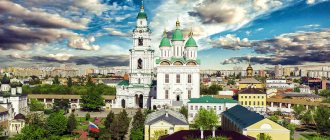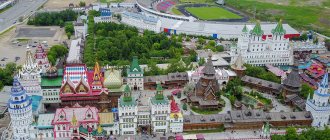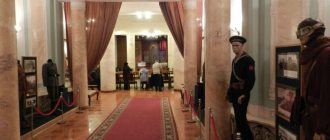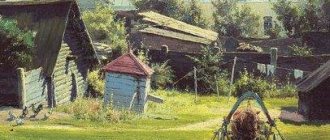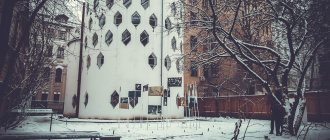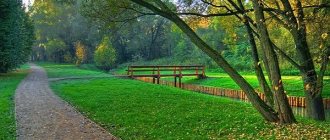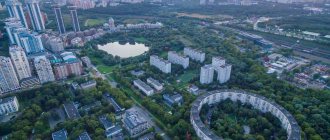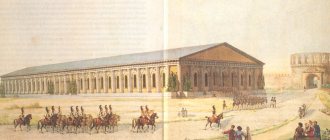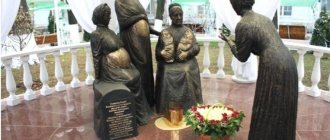The Moscow Kremlin is located on Borovitsky Hill. Its southern part faces the Moscow River, the eastern part borders Red Square, and Alexander Park is closely adjacent to the northwestern part. Currently, it is the residence of the president and an important political center of the entire country. It is generally accepted that the construction of the modern architectural and historical complex began in 1482 and was completed in 1495. The exact year of foundation of the very first fortress by Prince Yuri Dolgoruky is unknown, but already in 1156 wooden fortifications surrounded by a moat were built on the territory of the Kremlin. To find out who built the Moscow Kremlin, you need to turn to history.
The first settlements on the site of the Kremlin. Foundation of Moscow
The first ancient settlements on the site of the Kremlin arose a long time ago. According to archaeological excavations, about five thousand years ago. And already in the 6th century AD the first Slavic tribes appeared here.
Moscow was first mentioned in chronicles in 1147. It was then that Yuri Dolgoruky invited his cousin Prince Svyatoslav of Novgorod-Seversky to a meeting in a small border town. This event went down in history as the date of the founding of Moscow.
Faceted Chamber
The Faceted Chamber of the Moscow Kremlin is one of the few parts of the palace that have survived from the time of Ivan III. This was his ceremonial throne room. This is the oldest civil stone building in Moscow.
It was built in 4 years by Russian craftsmen with the help of invited Italians - Pietro Solari and Marco Ruffo.
The chamber is a square hall in which cross vaults rest on a pillar in the center of the room. The 9-meter-high hall is illuminated by well-placed 18 windows, as well as four massive chandeliers. The total area of the Faceted Chamber of the Moscow Kremlin is almost 500 square meters.
At the end of the 16th century, its walls were painted with church and biblical scenes. For centuries, the most important events in the history of the Russian state were celebrated here. Foreign embassies and delegations were received here, and the Zemsky Sobor met here. Victories of Russian weapons were regularly celebrated in the Faceted Chamber. For example, Ivan the Terrible celebrated the capture of Kazan, and Peter I celebrated the victory over the Swedes at Poltava.
The history of the creation of the first Kremlin
The history of the Kremlin begins a little later - nine years later, when Dolgoruky decides to fortify the city with high fortress walls. It was a pine palisade, supported by a massive earthen rampart for greater security. By the way, the place for construction was not chosen by chance. The fact is that the fortress was located on a high hill, surrounded by the Moscow River and Neglinnaya. This made it possible to notice the enemy in time and fight back. In addition, the hill offered an extremely picturesque view of the surrounding area. Interestingly, the area of the first Kremlin was about four hectares, and by now its territory has increased almost eight times!
But a significant drawback of this fortress was that it was built of wood, which means it could easily burn down during an accidental fire or arson. The next time the Kremlin was rebuilt at the beginning of the 14th century, when Moscow was ruled by Ivan Kalita. He invested a lot of money, effort and time in strengthening and decorating the city. For this purpose he ordered the construction of new fortress walls. These barriers became much stronger; they were built from powerful and durable oak trunks. And the new white-stone Kremlin in Moscow was built under Dmitry Donskoy several decades later.
Blagoveshchensky cathedral
The architecture of the Moscow Kremlin cannot be imagined without the Annunciation Cathedral. It is located in the southwestern part of Cathedral Square. It was built at the end of the 15th century. The work was carried out by Pskov craftsmen.
During the reign of Ivan the Terrible, a porch with a high porch made of white stone was added.
This temple of the Moscow Kremlin was built in the traditions of early Moscow architecture. Today, the frescoes of the cathedral, which appeared at the beginning of the 16th century, are of great interest. The main merit belongs to the artel of artists, which was led by Theodosius and his son Dionysius. There are many stories on the theme of the Apocalypse. You can also find secular motifs. For example, Russian princes and Byzantine emperors.
The floor of this cathedral is unique. It was laid with special tiles made of precious agate-like jasper.
Moscow during the time of Dmitry Donskoy
The next ruler of Moscow was Prince Dmitry Donskoy. He was the grandson of Ivan Kalita. It is known that Dmitry Donskoy pursued an active foreign policy, expanding and strengthening the territory of Moscow. In addition, this time was marked by furious raids of the Tatar-Mongol hordes. All this required new, more durable fortifications.
In addition, as already mentioned, the old Kremlin was built of wood. Therefore, although it was powerful enough to withstand enemy invasions, it still remained defenseless against fire. And the fire that happened in 1365 destroyed the entire city to the ground (in history it was called All Saints, as it began in the Church of All Saints). He did not spare the oak walls of the Kremlin. Then, in order to protect the city, Dmitry Donskoy orders to build a white stone Kremlin in Moscow. The year of construction began is 1367. This is mentioned in the chronicles of this period.
Construction of the white stone Kremlin
So, the construction of the white stone Kremlin in Moscow began. Throughout the winter, materials were transported to it to create a fortress. White stone for construction was mined in the Moscow region, thirty kilometers from the city. It has long been used in Rus' and was one of the most beloved materials. The white stone was durable and beautiful, but its extraction was difficult, and there were few masters of this craft. Therefore, it was not used very widely.
The white stone Kremlin in Moscow was the first such structure in Suzdal Rus'. Its construction began when all the materials were ready, namely in the spring of 1367. A strong foundation was laid under the walls of the new fortress, which still stands safely.
The construction of the white stone Kremlin in Moscow was carried out quickly (the year of its completion was 1368). This haste was entirely justified. Indeed, soon after the completion of construction, Moscow was attacked by the army of the Lithuanian prince Olgerd. He stood under the walls of the Kremlin for three days, but was never able to take the fortress. Two years later, Olgerd again attacked the city, but equally unsuccessfully.
In 1382, the fortress was subjected to a brutal attack by Tokhtamysh, which caused enormous damage to it, but after that it was completely restored. Therefore, the construction of the white stone Kremlin, without any doubt, was an outstanding historical event that influenced the further development of the city and its establishment as a center of Orthodoxy and the residence of the great princes.
White stone
Rus' already knew stone construction. But in many regions, strictly speaking, it was not stone, but brick - clay plinth was used. But in the Vladimir-Suzdal principality, even before the Mongol invasion, a tradition of building from limestone arose. Because of its light color it was called “white stone”. You had to know how to work with it, but in principle limestone was easy to work with. It was possible to cut blocks of the required size from it.
There was a limestone deposit not far from Moscow in the village of Myachkovo, 30 km from the capital. This variety is now called Myachkovsky limestone. The historian and writer I.E. Zabelin assumed that it was this stone that the builders of Dmitry Ivanovich’s Kremlin should have used.
The big problem was the delivery of stone, and the prince did not want to start construction until all the necessary material was at hand. Transportation was carried out along the Moscow River, partly by water, but mostly by ice in winter.
What did the white stone Kremlin look like?
Unfortunately, to date there have been no documentary reports about what the first white-stone Kremlin in Moscow looked like. This can be judged only thanks to the available information from chronicles and drawings by A. M. Vasnetsov.
It is known that stone walls and towers were built at a considerable distance from old structures. Therefore, the territory of the Kremlin expanded significantly. The thickness of the walls, according to some estimates, reached two to three meters. Also, the role of protective structures was played by a wide ditch, over which bridges were thrown.
Loopholes were installed in the walls, which were closed with strong wooden shields. Passage gates were built in six towers. The first stone bridge in Moscow was built across the Neglinnaya River. A century and a half later, Trinity was built in its place, which still stands today.
After construction was completed, the white stone Kremlin became the most powerful fortress in Europe. By the way, its area at that time almost reached the modern one.
Brick
At first glance, everything is much simpler with this. Even those who, according to history, never got out of two classes, know for sure that in 1812 the French were in the Kremlin. Those who have not yet completely forgotten everything can say that the Poles also visited there - they sat in the Kremlin for two years, from 1610 to 1612. Those who are considered advanced will remember that in 1571 Moscow was burned by the Crimean Khan Devlet Giray . Does it really mean that such a beautiful and powerful Kremlin is just a decoration and a passageway?
Never. All these three episodes have nothing to do with the siege and capture of fortresses. In 1812 Moscow was simply abandoned. In 1610, the Poles were brought there almost by force - traitors from among their own. Unless in 1571 the Crimeans tried to storm the Kremlin. But from a purely military point of view, nothing came of it - the walls stood.
How was the new Kremlin built?
The white stone Kremlin stood in Moscow for about 150 years. It was sieged many times and withstood the most ferocious attacks. But still they caused serious damage and destruction to it, as did frequent fires. The walls of the fortress had become dilapidated in many places and could no longer fulfill their protective role.
Therefore, in the second half of the 15th century, under Ivan the Third, a large-scale restructuring of the Kremlin began. For this purpose, famous Italian masters were invited to Moscow. The fortress was rebuilt gradually; new ones made of red brick were erected in place of the old white walls. In general, the reconstruction of the Kremlin took ten years. Temples and cathedrals were also rebuilt. This is how the modern architectural appearance of the Kremlin was formed.
Subsequently, it was rebuilt several times. The first changes were made during the reign of Boris Godunov, then under Peter I. The Patriotic War of 1812 caused great destruction to the Kremlin. After it, large-scale restoration work was carried out. Under Soviet rule, the Kremlin was also rebuilt several times, the towers were decorated with stars, and the Tsar Cannon and Tsar Bell were installed on pedestals.
Moscow white stone
The white stone Kremlin in Moscow stood for almost a century and a half. It withstood more than one fierce attack and enemy siege, reliably protecting the city from the enemy. It was thanks to this fortress that Moscow acquired the name “White Stone”. By the way, she still wears it now. But few people know that the Kremlin remained “white stone” for another four centuries after new red brick walls were erected.
There is a simple explanation for this unusual fact. The walls of the fortress were specially whitewashed until the 19th century. On the one hand, this was due to concern for the safety of the brick, on the other hand, it was a kind of tribute to the memory of the first stone Kremlin, built under Dmitry Donskoy. For example, it is depicted bleached on the canvas by P. P. Vereshchagin, created in 1879.
Creations of the masters
Although none of the figures of modern times saw the first Kremlin, it aroused their interest. Some tried to “invent” Dmitry Donskoy’s Kremlin and depict the results of their thoughts on canvas. The most interesting version belongs to the artist A. Vasnetsov. The whitewashed Kremlin of later eras was often drawn and described. One can suspect that not all the witnesses knew that before the fortress was different - really white.
The Kremlin today
Currently, the Kremlin is the residence of the President. In 1997, it underwent a large-scale restoration. During the work, a large number of buildings and structures of the Kremlin were restored. Nowadays, on major Orthodox holidays, ceremonial services are held there, and excursions are held around the territory and museums of the fortress.
And perhaps today not everyone remembers that the white stone Kremlin in Moscow was built under Dmitry Donskoy, but the indigenous residents of the capital know the history of their city and are proud of it.
Interesting Facts
- The architectural ensemble of Red Square and the Kremlin is included in the UNESCO World Cultural Heritage List.
- If several centuries ago the walls of the fortress were whitewashed, today they are periodically tinted with red paint.
- The Kremlin is the largest surviving fortress in Europe, still in operation.
- In 1941, windows were painted on the walls. This was done in order to disguise the fortress as a residential building.
The white-stone Kremlin in Moscow has gone through many changes during its life, but remains a symbol of Moscow and a true pearl of the city’s architecture.
Back to white
Nowadays the red walls of the Kremlin are tinted with red paint for showiness in the same way as they used to be whitewashed. But in recent years, proposals have increasingly been heard to repaint the Kremlin white again. They say this will be more in keeping with the historical spirit of Moscow.
Besides the fact that it doesn’t hurt to think about how much paint it will require and how much the work will cost, you need to remember two more things. Firstly, the current Kremlin was not born white-stone. Repainting will not restore the real fortress of Dmitry Donskoy. And secondly, the Kremlin and Red Square are a monument of world significance and are under the protection of UNESCO.
